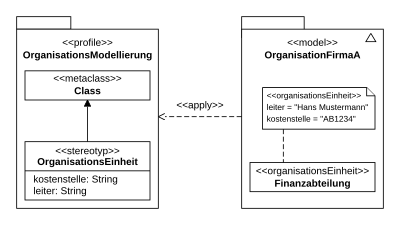Profile diagram
| Structure diagrams of the UML |
|---|
| Class diagram |
| Component diagram |
| Composition structure diagram |
| Object diagram |
| Package diagram |
| Profile diagram |
| Distribution diagram |
| UML behavioral diagrams |
| Activity diagram |
| Use case diagram |
| Interaction overview diagram |
| Communication diagram |
| Sequence diagram |
| Timing diagram |
| State diagram |
The profile diagram is one of the 14 types of diagram in the Unified Modeling Language (UML), a modeling language for software and other systems. It is used in the metamodel level to display so-called stereotypes with classes, which are then given the name <<stereotype>>or for profiles and packages <<profile>>. The extended relation (solid line with closed and filled arrows) indicates which metamodel element extends a given stereotype.
history
The profile diagram was not intended in UML1. It was only added to the diagrams with UML2 to illustrate the elementary use of profiles. Before that, others such as B. Class diagrams can be used.
Individual evidence
- ↑ a b Bernd Oestereich : Analysis and Design with UML 2.3 - Object-Oriented Software Development . 9th edition. Oldenbourg, Munich 2009, ISBN 978-3-486-58855-2 , pp. 334 ( limited preview in Google Book search).
